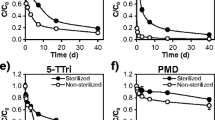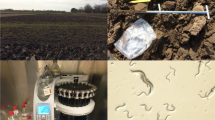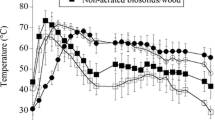Abstract
Biological degradation rates of estrogen compounds and common pharmaceutical and personal care products (PPCPs) were examined in soils with a long history of exposure to these compounds through wastewater effluent and in soil not previously exposed. Biological degradation rates over 14 days were compared under aerobic and anaerobic conditions. Estrogen compounds including estrone, 17β-estradiol, estriol, and 17α-ethinylestradiol exhibited rapid degradation by soil microorganisms in both aerobic and anaerobic conditions. Rapid degradation rates for estrone, estriol, and 17α-ethinylestradiol occurred in pre-exposed soil under aerobic conditions; half-lives calculated under these conditions were 0.6, 0.7, and 0.8 day, respectively. Unexposed soil showed similar or slightly longer half-lives than pre-exposed soil under aerobic conditions. The exception was 17β-estradiol; in all treatments, degradation in unexposed soil resulted in a shorter half-life (2.1 versus 2.3 days). Anaerobic soils exhibited high biological degradation of estrogens as well. Half-lives of all estrogens ranged from 0.7 to 6.3 days in anaerobic soils. Triclosan degraded faster under aerobic conditions with half-lives of 5.9 and 8.9 days in exposed and unexposed soil. Under anaerobic conditions, triclosan half-lives were 15.3 days in unexposed and 28.8 days in exposed soil. Ibuprofen showed the least propensity toward biological degradation than other chemicals tested. Biological degradation of ibuprofen was only observed in unexposed soil; a half-life of 41.2 days was determined under anaerobic conditions and 121.9 days under aerobic conditions. Interestingly, unexposed soil exhibited a greater ability under anaerobic conditions to biologically degrade tested compounds than previously exposed soil.






Similar content being viewed by others
References
Andersen, H., Siegrist, H., Halling-Sorensen, B., & Ternes, T. A. (2003). Fate of estrogens in a municipal sewage treatment plant. Environmental Science & Technology, 37(18), 4021–4023.
Beare, M. H., Coleman, D. C., Crossley, D. A., Hendrix, P. F., & Odom, E. P. (1995). A hierarchical approach to evaluating the significance of soil biodiversity to biogeochemical cycling. Plant and Soil, 170, 5–22.
Braga, O., Smythe, G. A., Schafer, A. I., & Feitz, A. J. (2005). Fate of steroid estrogens in Australian inland and coastal wastewater treatment plants. Environmental Science & Technology, 39(9), 3351–3358.
Brahushi, F., Dörfler, U., Schroll, R., & Munch, J. C. (2004). Stimulation of reductive dechlorination of hexachlorobenzene in soil by inducing the native microbial activity. Chemosphere, 55(11), 1477–1484.
Buckley, D. H., & Schmidt, T. M. (2003). Diversity and dynamics of microbial communities in soils from agro-ecosystems. Environmental Microbiology, 5(6), 441–452.
Chen, Y., & Rosazza, J. P. N. (1994). Microbial transformation of ibuprofen by a Nocardia species. Applied and Environmental Microbiology, 60, 1292–1296.
Chowdhury, B., Roy, D., Chavan, U., & Mukhopadhyay, S. (1996). The anti-inflammatory, antipyretic, analgesic compound ibuprofen also has antibacterial activity against Gram-positive bacteria. Medical Science Research, 24, 801–802.
Chuanchuen, R., Karkhoff-Schweizer, R. R., & Schweizer, H. P. (2003). High-level triclosan resistance in Pseudomonas aeruginosa is solely a result of efflux. American Journal of Infection Control, 31(2), 124–124.
Clausen, C.A. (1996). Ibuprofen inhibits in vitro growth of brown-rot fungi. USDA, F.P.L., Madison, WI: International Research Group on Wood Preservation Section 1.
Coombe, R. G., Tsong, Y. Y., Hamilton, P. B., & Sih, C. J. (1966). Mechanisms of steroid oxidation by microorganisms. The Journal of Biological Chemistry, 241(7), 1587–1595.
Drewes, J. E., Heberer, T., Rauch, T., & Reddersen, K. (2003). Fate of pharmaceuticals during groundwater recharge. Ground Water Monitoring and Remediation, 23(3), 64–72.
Focazio, M. J., Kolpin, D. W., Barnes, K. K., Furlong, E. T., Meyer, M. T., Zaugg, S. D., et al. (2008). A national reconnaissance for pharmaceuticals and other organic wastewater contaminants in the United States-II: untreated drinking water sources. The Science of the Total Environment, 402(2–3), 201–216.
Furuichi, T., Kannan, K., Suzuki, K., Tanaka, S., Giesy, J. P., & Masunaga, S. (2006). Occurrence of estrogenic compounds in and removal by a swine farm waste treatment plant. Environmental Science & Technology, 40(24), 7896–7902.
Golet, E. M., Xifra, I., Siegrist, H., Alder, A. C., & Giger, W. (2003). Environmental exposure assessment of fluoroquinolone antibacterial agents from sewage to soil. Environmental Science & Technology, 37(15), 3243–3249.
Gomes, R. L., Avcioglu, E., Scrimshaw, M. D., & Lester, J. N. (2004). Steroid estrogen determination in sediment and sewage sludge: a critique of sample preparation and chromatographic/mass spectrometry considerations, incorporating a case study in method development. TrAC, Trends in Analytical Chemistry, 23(10–11), 737–744.
Hermanowicz, S. W., & Wozei, E. (Eds.) (2002). Biodegradation of estrogenic compounds and its enhancement in a membrane bioreactor. Technical Completion Report, University of California Water Resources Center 11 Project Number W-944.
Jurgens, M. D., Holthaus, K. I. E., Johnson, A. C., Smith, J. J. L., Hetheridge, M., & Williams, R. J. (2002). The potential for estradiol and ethinylestradiol degradation in English rivers. Environmental Toxicology and Chemistry, 21(3), 480–488.
Karnjanapiboonwong, A., Morse, A. N., Maul, J. D., & Anderson, T. A. (2010). Sorption of estrogens, triclosan, and caffeine in a sandy loam and a silt loam soil. Journal of Soils and Sediments (in press).
Kolpin, D. W., Furlong, E. T., Meyer, M. T., Thurman, E. M., Zaugg, S. D., Barber, L. B., et al. (2002). Pharmaceuticals, hormones, and other organic wastewater contaminants in US streams, 1999-2000: A national reconnaissance. Environmental Science & Technology, 36(6), 1202–1211.
Korner, W., Bolz, U., Sussmuth, W., Hiller, G., Schuller, W., Hanf, V., et al. (2000). Input/output balance of estrogenic active compounds in a major municipal sewage plant in Germany. Chemosphere, 40, 1131–1142.
Kummerer, K. (2001). Drugs in the environment: emission of drugs, diagnostic aids and disinfectants into wastewater by hospitals in relation to other sources—a review. Chemosphere, 45(6–7), 957–969.
Layton, A. C., Gregory, B. W., Seward, J. R., Schultz, T. W., & Sayler, G. S. (2000). Mineralization of steroidal hormones by biosolids in wastewater treatment systems in Tennessee USA. Environmental Science & Technology, 34(18), 3925–3931.
Lee, H. B., & Liu, D. (2002). Degradation of 17 beta-estradiol and its metabolites by sewage bacteria. Water, Air, and Soil Pollution, 134, 353–368.
Li, F., Yuasab, A., Obarac, A., & Mathews, A. P. (2005). Aerobic batch degradation of 17-β estradiol (E2) by activated sludge: Effects of spiking E2 concentrations, MLVSS and temperatures. Water Research, 39, 2065-2075.
Middeldorp, P. J. M., van Doesburg, W., Schraa, G., & Stams, A. J. M. (2005). Reductive dechlorination of hexachlorocyclohexane (HCH) isomers in soil under anaerobic conditions. Biodegradation, 16(3), 283–290.
Norris, D. O., & Carr, J. A. (Eds.) (2006). Endocrine disruption biological bases for health effects in wildlife and humans, New York: Oxford University Press.
Paul, E. A. (2007). Soil microbiology, ecology and biochemistry. Burlington: Academic.
R Development Core Team (2004). R—A language and environment for statistical computing: Vienna, Austria. R Foundation for Statistical Computing. ISBN 3-900051-07.0 at http://www.R-project.org.
Reiss, R., Lewis, G., & Griffin, J. (2009). An ecological risk assessment for triclosan in the terrestrial environment. Environmental Toxicology and Chemistry, 28(7), 1546–1556.
Richardson, M. L., & Bowron, J. M. (1985). The fate of pharmaceutical chemicals in the aquatic environment. The Journal of Pharmacy and Pharmacology, 37, 1–12.
Sanyal, A. K., Roy, D., Chowdhury, B., & Banerjee, A. B. (1993). Ibuprofen, a unique antiinflamatory compound with antifungal activity against dematophytes. Letters in Applied Microbiology, 17(3), 109–111.
Shi, J. H., Suzuki, Y., Nakai, S., & Hosomi, M. (2004). Microbial degradation of estrogens using activated sludge and night soil-composting microorganisms. Water Science and Technology, 50(8), 153–159.
Slater-Radosti, C., Van Aller, G., Greenwood, R., Nicholas, R., Keller, P. M., DeWolf, W. E., et al. (2001). Biochemical and genetic characterization of the action of triclosan on Staphylococcus aureus. The Journal of Antimicrobial Chemotherapy, 48(1), 1–6.
Suzuki, Y., & Maruyama, T. (2006). Fate of natural estrogens in batch mixing experiments using municipal sewage and activated sludge. Water Research, 40, 1061–1069.
Ternes, T. A. (1998). Occurrence of drugs in German sewage treatment plants and rivers. Water Research, 32(11), 3245–3260.
Torsvik, V., & Øvreås. (2002). Microbial diversity and function in soil: from genes to ecosystems. Current Opinion in Microbiology, 5, 240–245.
USDA: Soil Survey of Lubbock County Texas, (2007). Accessed at http://websoilsurvey.nrcs.usda.gov/app/WebSoilSurvey.aspx. Accessed February 2009.
Wright, H. T., & Reynolds, K. A. (2007). Antibacterial targets in fatty acid biosynthesis. Current Opinion in Microbiology, 10(5), 447–453.
Xu, N., Johnson, A. C., Jürgens, M. D., Llewellyn, N. R., Hankins, N. P., & Darton, R. C. (2009). Estrogen concentration affects its biodegradation rate in activated sludge. Environmental Toxicology and Chemistry, 28(11), 2263–2270.
Ying, G. G., & Kookana, R. S. (2007). Triclosan in wastewaters and biosolids from Australian wastewater treatment plants. Environment International, 33(2), 199–205.
Ying, G. G., Kookana, R. S., & Dillon, P. (2003). Sorption and degradation of selected five endocrine disrupting chemicals in aquifer material. Water Research, 37(15), 3785–3791.
Acknowledgment
This research was partially supported by the US EPA and TWRI grant #2009TX325B funded through the USGS 104b program.
Author information
Authors and Affiliations
Corresponding author
Rights and permissions
About this article
Cite this article
Carr, D.L., Morse, A.N., Zak, J.C. et al. Microbially Mediated Degradation of Common Pharmaceuticals and Personal Care Products in Soil Under Aerobic and Reduced Oxygen Conditions. Water Air Soil Pollut 216, 633–642 (2011). https://doi.org/10.1007/s11270-010-0558-y
Received:
Accepted:
Published:
Issue Date:
DOI: https://doi.org/10.1007/s11270-010-0558-y




